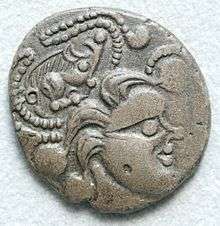Baiocasses

The Baiocasses were a Celtic tribe (pagus) in ancient Gaul. They were a tribal division of the civitas of the Lexovii, in the Roman province of Gallia Lugdunensis.
The Baiocasses were located east of the Venelli and west of the Belgic Veliocasses. The Latin name for their territory was the Pagus Baiocensis, corresponding to the area in Normandy now known as le Bessin. This is the location of the modern city of Bayeux, which takes its name from the tribe. Their principal city was known during the late Roman Imperial era as Civitas Baiocassium ("City of the Baiocasses"), from which Bayeux derives. Earlier it had been called Augustodurum, named as were several new Gallo-Roman towns for the emperor Augustus and compounded with the Gaulish word duron, "gate" and hence "enclosed place, market, forum; walled town."[1] By Merovingian times, the city was called Baiocas. In the time of William the Conqueror the name was already being written as Bayeaux.
Julius Caesar does not mention the Baiocasses in his commentaries on the Gallic Wars of the 50s BC, but they are listed in the Notitia dignitatum and are probably the same people Pliny calls Bodiocasses.[2] The Celtic word badios or bodios, "yellow, blond," forms several personal names found in Gaulish inscriptions. The meaning of the element -casses is less certain; it may mean "hair, hairstyle," perhaps a particular warrior coiffure, or "tin, bronze (helmet?)."[3]
The Baiocasses minted base gold, silver and billon (base silver) coins in the denomination of one stater and in the case of gold coins sometimes quarter staters. Most of the coins show a Celtic-style male head with elaborated hair on the obverse, and on the reverse a horse with a chariot rider above or behind, and below usually either a lyre or small boar. A number of these are in existence.[4]
The 4th-century Bordelaise poet Ausonius teases a friend as a Baiocassis who claimed to be of druidic heritage and descended from priests of Belenus.[5]
References
- ↑ Xavier Delamarre, Dictionnaire de la langue gauloise (Éditions errance, 2003), pp. 63 and 156–157.
- ↑ Pliny, Natural History 4.107 (Latin edition).
- ↑ Delamarre, Dictionnaire, pp. 63 and 109–110.
- ↑ BAIOCASSES - BAIOCASSES - (Région de BAYEUX) - (Ier siècle avant J.-C.) - Statère d'argent fourré - c. 60-50 AC. - VSO 15.
- ↑ Ausonius, Commemoratio professorum Burdigalensium 4.7; Altay Coşkun with Jürgen Zeidler, "'Cover Names' and Nomenclature in Late Roman Gaul: The Evidence of the Bordelaise Poet Ausonius" (2003), pp. 6–7.
Bibliography
- Smith, William, ed. 1854. Dictionary of Greek and Roman Geography, illustrated by numerous engravings on wood. London: Walton and Maberly (13.04)
- Hazlit, William. 1851. The Classical Gazetteer. Online version at AncientLibrary.com
